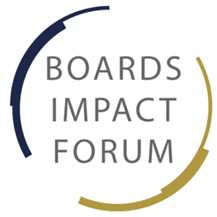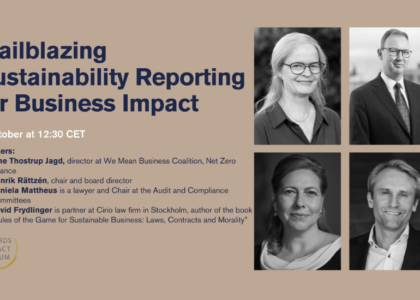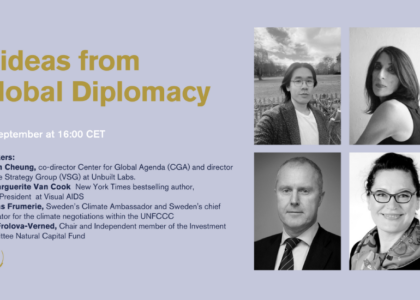Author: Niclas Ihrén, Founder and CEO of Matters Group
Sustainability issues and not least climate change are transformative issues for all of society. They impact us in so many ways, through everything from extreme weather to a rapidly changing energy system, changed legislation and regulations, and new consumer preferences and behaviors.
These are far reaching changes central to our businesses also of course. All companies, more or less, have these issues on their agenda today. The issues are necessary to manage where they appear, as operational and tactical issues, as well as more far-reaching strategic issues.
It is an obligation for the corporate board of directors to manage the issues, but many boards lack sufficient tools and knowledge, since these are new areas on the agenda for the board. There are many compliance issues related to sustainability and climate, and there is an evident risk that the main lens through which these issues are dealt with, is through compliance and reporting, since that lens exposes the most urgent operational risks and needs to be addressed.
However, if we really see the issues as transforming for all markets for the long-term, the board has a more important role in setting direction for strategy, business model changes, and innovation that is aligned with future demands.
Here I will describe some useful tools and methods that a board can use to frame these issues in a productive way. The workshop tools described can be used for any sustainability issue, and the board should really make the effort to analyze all significantly material issues. But here, I will focus on climate change, to provide a tangible example.
Below is a structured approach with three steps, to try and analyze the strategic implications for the company. A good start is a 1-3 hour workshop for the board, and/or together with your management team. Of course you can spend a lot more time depending on how deeply you want to go. You will benefit of sharing pre-read material, potentially start with a framing presentation, and use a competent facilitator. But most important is to get started. The approach we propose that boards can use, is to engage in a learning and reflection method, where we stepwise zoom closer to our business, starting at the societal level. The steps are:
1. Transformative issues
2. Transformed market
3. Transformed business model
Table of Contents
1. Transformative issues

The first step is to try and concretize how the issues will have a transformative impact on society, and thereby also on the relevant context for the company. When we talk about climate change, the immediate perspective is the changes happening to the climate itself. However, that is in many ways the slowest part of the change. It becomes very useful to look at the issues by including more direct changes relevant to the business. A useful breakdown is through the following domains, e g
- How will climate change in a significant way?
- How will climate change impact the regulatory landscape?
- How will consumer behaviors change over time?
- How will corporate behaviors generally change over time?
- What are the most important technology responses to the above?
For each of the questions or domains above, discuss three perspectives:
1.1 What is the nature of the change?
1.2 How transformative is it? (high, medium, low)
1.3 When will it happen (1-3 years from now, 3-5 years, or longer)
If the board is reviewing and discussing the above questions on transformative issues as primarily answered by the management team, the board still needs to have their own perspectives of the answers:
- What is management’s perspective on above, and how does it correlate with experts’ views and the board members’ views?
- What signals do we see that confirm or reject the findings?
- What further insights do we need to complement with, to evaluate the findings?
- What if we are wrong in terms of speed and impact of the changes?
The point with the domains (a-e) above is that typically changes go faster as you move downwards. Technology can change very fast, behaviors a little slower, regulatory landscape even slower and the physical changes are the slowest. This is a generalization, and it may be different also, but we will by looking at a complex issue like climate change in this way be able to come much closer to what is relevant to the business here and now.
It is good to do the above like a table where you mark red where transformation goes faster etc, in order to focus attention to where it is most important.
2. Transformed market

The second step in this method is to discuss how our markets will be transforming, based on the insights from the first exercise. We zoom in on what is really happening in our own relevant market landscape. We will look at our market from three different stakeholder perspectives. These three perspectives can benefit from doing some preparatory desktop research before the workshop, to have more facts on the table. But you should also base the discussion on the knowledge in the room.
The three perspectives we will use are:
- Solution providers
- Competitors
- Customers, partners and suppliers
Solution providers
We see climate change as transformative to our market for the long-term, and it has already started. What typically happens is that some new niche opportunities start to appear in the market based on some of the changes we discussed in the first exercise. Let us look at the motorcycle industry, as an example. Climate change is real. Fossil fuels need to be phased out, it has gone further and faster in some other segments. Consumer preferences are changing. A niche is opening for electric motorcycles. That is what I mean by solution providers. These are new companies that are building their business based on a new niche which is opening up as a consequence of climate change. But these niches can be anything really. The point is that the new players, the solution providers, exploring the niches intend to accelerate the change, because that is what will benefit their business most.
The questions we ask ourselves here are:
2.a.1 What new niches are emerging, and who are the new players?
2.a.2 How rapidly will our markets transform based on these expanding niches?
Competitors
Next we look at our competitors. What we want to do is to get an understanding of what our most important competitors are doing to address climate change, by looking at their external communication and through other knowledge we may have. We look at our competitors with two perspectives. On one hand, what are they doing in terms of compliance and risk management. This is important, because we can learn and benchmark. There may be risks that we have overlooked, or our competitor may have a better structured response than we have.
On the other hand, we want to look at them from an impact and innovation perspective. Storytelling and Impact are good ways of building stronger bonds and synergies with customers. This is where our competitors build their competitive advantage, so we do not want to do exactly the same. We need to understand what is going on, in order to differentiate ourselves.
The key questions when looking at our competitors are:
- What can we learn from our competitors?
- How do we differentiate ourselves from our competitors?
Customers, partners and suppliers
As a third part of step 2, we want to look at a selection of our customers, partners and suppliers, and what they are doing. The general perspectives to be used are the same as when looking at competitors: on one hand a risk and compliance perspective. On the other hand an impact and innovation perspective.
With customers, partners and suppliers, we wish to build strong and value creating relations. We need to understand their preferences and they need to understand ours.
There are also two key questions we wish to find the answer to here:
- What do our customers, partners and suppliers expect from us and from our approach to climate change, and how can we meet those expectations in a prioritized and effective way?
- What are the opportunities for synergies in creating impact and innovations in our climate change approach with our customers, partners and suppliers. How can we work closer together to generate mutual opportunity and value?
If the board is reviewing and discussing the above questions on the transforming market as primarily answered by the management team, again the board still needs to have its own perspective of the answers.
- What is management’s perspective on above, and how does it correlate with experts’ views and the board members’ views?
- What signals do we see that confirm or reject the findings?
- What further insights do we need to complement with, to evaluate the findings?
- What if we are wrong in terms of speed and impact of the changes?
- What risks could we endure, what opportunities might we miss?
- What further initiatives or experiments could, and should, we engage in?
3. Transformed business model

The third step of the workshop is about how the company can be strengthened for the future through changes to the business model(s). We look at opportunities for development in order to harness the insights from the previous two steps. There may of course be insights regarding operational changes in risk management and compliance that have come through the previous steps also, but here we will focus on the opportunity side.
If we think of climate change as one of the defining challenges for our global society this century, it becomes obvious that if our company can be a part of the solution rather than a part of the problem, that will make a huge difference for the long term. In order to be a part of the solution, our positive impact should be much greater than our negative footprint. To find the right ambition for positive impact, we need to think openly and with vision about how our business can contribute together with others. If we are to have big impact, it is not something we do on our own, but something we need to create through strong partnerships in a business ecosystem.
The key questions we are discussing in this step are:
- What is the positive climate impact we wish to be a part of, and how do we translate this into an ambitious, clear and engaging vision?
- Who should we collaborate with in order to make the vision possible, credible and engaging?
- How can we realize the vision through an upgraded value proposition to the market, including high-level rethinking of our products/services?
- How do we mobilize strong internal and external engagement and participation around the vision?
In this step, we can revisit the outcomes of all the previous, in order to keep the big transformative visions alive. Are we really meeting the most transformative changes we listed in step 1? What is our position relative to the solution providers in step 2? Should we work with them? Buy them? Etc.
If the board is reviewing and discussing the above questions on the transformed business model as primarily answered by the management team, and as above, the board still needs to have its own perspective of the answers.
- What is management’s perspective on above, and how does it correlate with experts’ views and the board members’ views?
- What signals do we see that confirm or reject the findings?
- What further insights do we need to complement with, to evaluate the findings?
- Have we the appropriate skills and have we organized ourselves on both board and management levels to ensure the best outcome for the company?
- What ambitions are we agreeing on for our company and how do we integrate them into our business strategy?
- What timelines are we expecting from management for the next steps?
- What incentives do we need to adjust to encourage the transformation?
- What communication do we expect from management, internally and externally?
This workshop is designed to generate a learning and a strategic discussion based on sufficient relevant substance regarding climate change and how it affects our market, and bring input to both short- and long-term actions for the company. Of course, the more real data we have on the table, the better the discussion and corresponding conclusions. If we see the opportunity for great changes to our business, there is naturally a lot of work to be done regarding plans, budgets, organization etc. This workshop can provide a good start to vitalize the necessary discussion among the board of directors, and balance the compliance and reporting that most companies will be forced into over the coming years.

Boards Impact Forum, the Nordic Chapter of Climate Governance Initiative in collaboration with World Economic Forum, aims to enable better corporate climate and sustainability governance by inspiring, educating, connecting, and engaging board members in Nordic countries and internationally. We share insights together with our partners via webinars, peer exchanges, events, research, and information sharing, and collaborates with the other country and regional chapters of the Climate Governance Initiative.
We welcome all responsible board members to become members at Boards Impact Forum, and we invite Partners to support our important initiative, learn more here .
Follow our upcoming events here, and revisit some earlier events here
The importance of managing the sustainability agenda and the climate issue by boards is increasing. Boards Impact Forum, the Nordic chapter of the Word Economic Forum’s Climate Governance Initiative (CGI), has been established to provide more insights. The Boards Impact Forum purpose is to engage board members in the Nordic region and internationally, to accelerate climate action and innovation for more sustainable business and a sustainable world. More information about Boards Impact Forum can be found here: https://boardsimpactforum.com/








Recent Comments